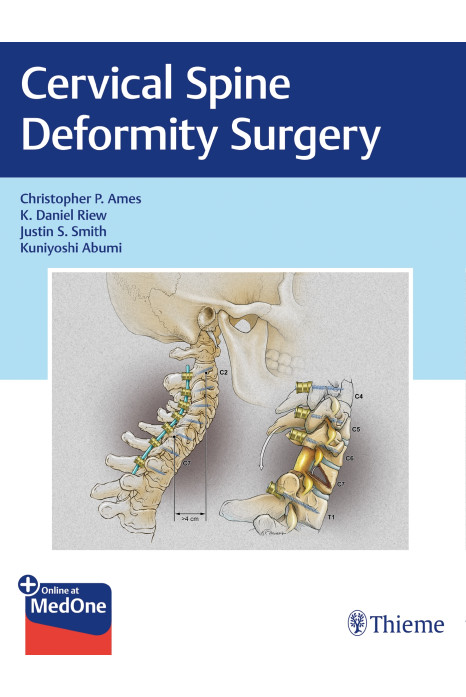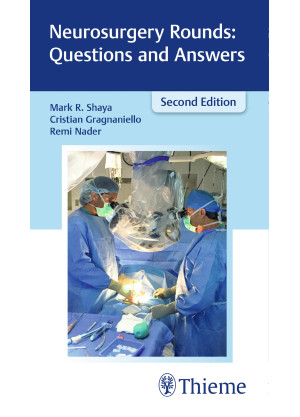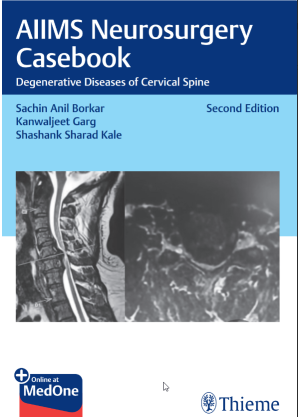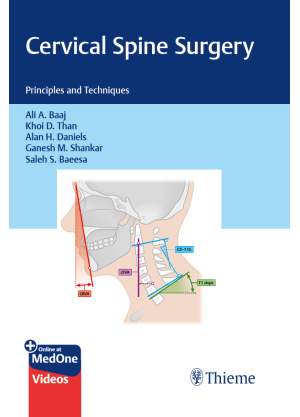The first comprehensive book dedicated solely to the evaluation and treatment of cervical spine deformity!
The number of cervical fusion procedures has increased in the U.S. and globally during the last decade, in part due to an aging population and higher incidence of complex cervical problems. Despite advances in the surgical treatment of cervical deformities, few resources detail modern clinical assessment, radiographic evaluation, and surgical approaches. Cervical Spine Deformity Surgery by world-renowned spine surgeons Christopher Ames, K. Daniel Riew, Justin Smith, and Kuniyoshi Abumi fills a void in the literature. It provides a concise, state-of-the-art resource on current cervical deformity knowledge compiled from the literature and recognized masters in the field.
The generously illustrated text begins with a background on the marked health impact of cervical deformity. Opening chapters provide primers on the clinical and radiographic assessment of patients, malalignment and disability scores, and the physical exam. Subsequent chapters detail surgical planning and approaches for a full spectrum of cervical spine conditions, such as semi-rigid and rigid deformities, sagittal deformities, distal junctional kyphosis, congenital cervical deformity, and hemivertebra.
Key Features
- Insightful technical nuances and pearls on managing surgical, neurological, and medical complications associated with cervical procedures, as well as risk stratification and patient frailty
- Diverse osteotomies including low grade, uncovertebral joint (anterior view), cervical pedicle subtraction, cervical opening wedge, upper thoracic, C1-2 joint, and cervical pedicle screw fixation
- Focused discussion on continuing efforts to create a clinically meaningful comprehensive cervical osteotomy classification system
Neurosurgical and orthopaedic residents and practicing spine surgeons who treat patients with cervical deformities will greatly benefit from consulting this comprehensive and unique resource.
This book includes complimentary access to a digital copy on https://medone.thieme.com.
1. Adult Cervical Spinal Deformity and Comparative Impact on Health
2. Global Sagittal Alignment
3. Cervical Spine Alignment
4. Radiographic Measurement
5. Cervical Disability Assessment
6. Cervical Malalignment and Disability Scores
7. Physical Examination of Cervical Deformity
8. Cervical Osteotomy Types
9. Technique of Low-Grade Osteotomies for Semi-Rigid Deformities
10. Uncovertebral Joint Osteotomy (Anterior Riew Osteotomy) for Correction of Rigid Cervical Spine Deformity
11. Cervical Pedicle Subtraction Osteotomy for Correction of Sagittal Deformities
12. Cervical Opening Wedge Osteotomy
13. Cervical Pedicle Screw Fixation
14. Upper Thoracic Osteotomy for Cervical Deformity
15. Osteotomy in the Thoracolumbar Spine for Cervical Deformity
16. Congenital Cervical Deformity and Hemivertebra
17. Risk Stratification and Frailty in Complex Cervical Surgery
18. Surgical and Neurological Complications
19. Medical Complications
20. Relationship of Cervical Spondylotic Myelopathy to Cervical Deformity
21. C1-C2 Joint Osteotomy and Reduction of Vertical Deformity
22. Cervical Deformity Classification
23. Distal Junctional Kyphosis and Fusion Level Selection
24. Fusion Level Selection in Cervical Deformity











